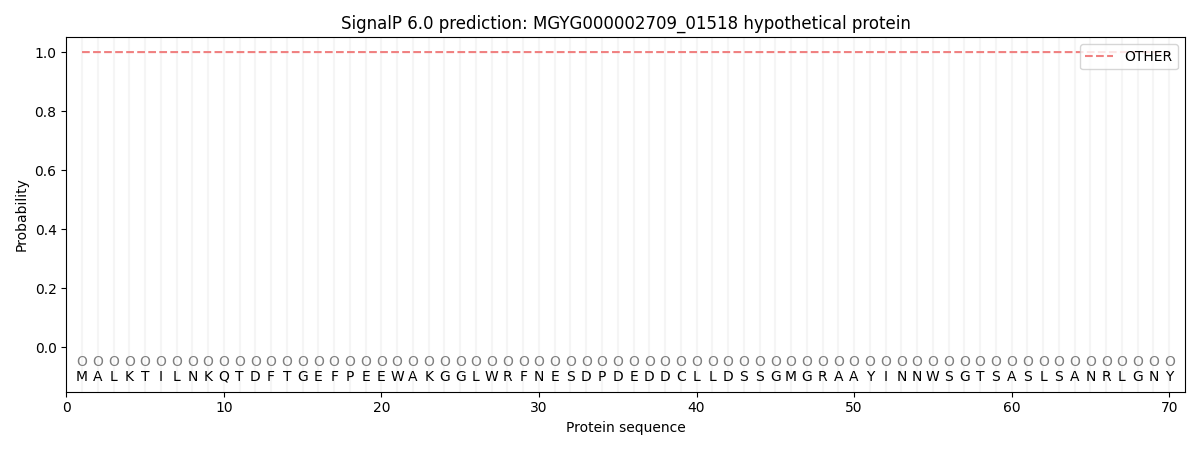You are browsing environment: HUMAN GUT
CAZyme Information: MGYG000002709_01518
You are here: Home > Sequence: MGYG000002709_01518
Basic Information |
Genomic context |
Full Sequence |
Enzyme annotations |
CAZy signature domains |
CDD domains |
CAZyme hits |
PDB hits |
Swiss-Prot hits |
SignalP and Lipop annotations |
TMHMM annotations
Basic Information help
| Species | UMGS1623 sp900553525 | |||||||||||
|---|---|---|---|---|---|---|---|---|---|---|---|---|
| Lineage | Bacteria; Firmicutes_A; Clostridia; Oscillospirales; Acutalibacteraceae; UMGS1623; UMGS1623 sp900553525 | |||||||||||
| CAZyme ID | MGYG000002709_01518 | |||||||||||
| CAZy Family | GH73 | |||||||||||
| CAZyme Description | hypothetical protein | |||||||||||
| CAZyme Property |
|
|||||||||||
| Genome Property |
|
|||||||||||
| Gene Location | Start: 4818; End: 8003 Strand: + | |||||||||||
CDD Domains download full data without filtering help
| Cdd ID | Domain | E-Value | qStart | qEnd | sStart | sEnd | Domain Description |
|---|---|---|---|---|---|---|---|
| pfam06605 | Prophage_tail | 4.06e-39 | 473 | 629 | 1 | 165 | Prophage endopeptidase tail. This family is of prophage tail proteins that are probably acting as endopeptidases. |
| TIGR01665 | put_anti_recept | 1.06e-18 | 407 | 616 | 1 | 239 | phage minor structural protein, N-terminal region. This model represents the conserved N-terminal region, typically from about residue 25 to about residue 350, of a family of uncharacterized phage proteins 500 to 1700 residues in length. [Mobile and extrachromosomal element functions, Prophage functions] |
| cd06583 | PGRP | 2.81e-15 | 628 | 729 | 49 | 123 | Peptidoglycan recognition proteins (PGRPs) are pattern recognition receptors that bind, and in certain cases, hydrolyze peptidoglycans (PGNs) of bacterial cell walls. PGRPs have been divided into three classes: short PGRPs (PGRP-S), that are small (20 kDa) extracellular proteins; intermediate PGRPs (PGRP-I) that are 40-45 kDa and are predicted to be transmembrane proteins; and long PGRPs (PGRP-L), up to 90 kDa, which may be either intracellular or transmembrane. Several structures of PGRPs are known in insects and mammals, some bound with substrates like Muramyl Tripeptide (MTP) or Tracheal Cytotoxin (TCT). The substrate binding site is conserved in PGRP-LCx, PGRP-LE, and PGRP-Ialpha proteins. This family includes Zn-dependent N-Acetylmuramoyl-L-alanine Amidase, EC:3.5.1.28. This enzyme cleaves the amide bond between N-acetylmuramoyl and L-amino acids, preferentially D-lactyl-L-Ala, in bacterial cell walls. The structure for the bacteriophage T7 lysozyme shows that two of the conserved histidines and a cysteine are zinc binding residues. Site-directed mutagenesis of T7 lysozyme indicates that two conserved residues, a Tyr and a Lys, are important for amidase activity. |
| pfam18994 | Prophage_tailD1 | 3.35e-14 | 390 | 471 | 1 | 84 | Prophage endopeptidase tail N-terminal domain. This domain represents the N-terminal domain of prophage tail proteins that are probably acting as endopeptidases. This domain has a RIFT related fold. |
| smart00644 | Ami_2 | 4.06e-10 | 628 | 716 | 46 | 119 | Ami_2 domain. |
CAZyme Hits help
| Hit ID | E-Value | Query Start | Query End | Hit Start | Hit End |
|---|---|---|---|---|---|
| AFC63685.1 | 2.03e-317 | 628 | 1061 | 66 | 499 |
| ADL53623.1 | 1.45e-219 | 628 | 1060 | 66 | 488 |
| QJU15163.1 | 3.13e-175 | 628 | 1010 | 66 | 452 |
| QUO23193.1 | 9.27e-143 | 768 | 1060 | 1 | 294 |
| QMW80001.1 | 4.98e-106 | 628 | 1060 | 63 | 501 |
Swiss-Prot Hits download full data without filtering help
| Hit ID | E-Value | Query Start | Query End | Hit Start | Hit End | Description |
|---|---|---|---|---|---|---|
| O51481 | 9.73e-22 | 776 | 925 | 50 | 192 | Uncharacterized protein BB_0531 OS=Borreliella burgdorferi (strain ATCC 35210 / DSM 4680 / CIP 102532 / B31) OX=224326 GN=BB_0531 PE=3 SV=1 |
SignalP and Lipop Annotations help
This protein is predicted as OTHER

| Other | SP_Sec_SPI | LIPO_Sec_SPII | TAT_Tat_SPI | TATLIP_Sec_SPII | PILIN_Sec_SPIII |
|---|---|---|---|---|---|
| 1.000064 | 0.000001 | 0.000000 | 0.000000 | 0.000000 | 0.000000 |
